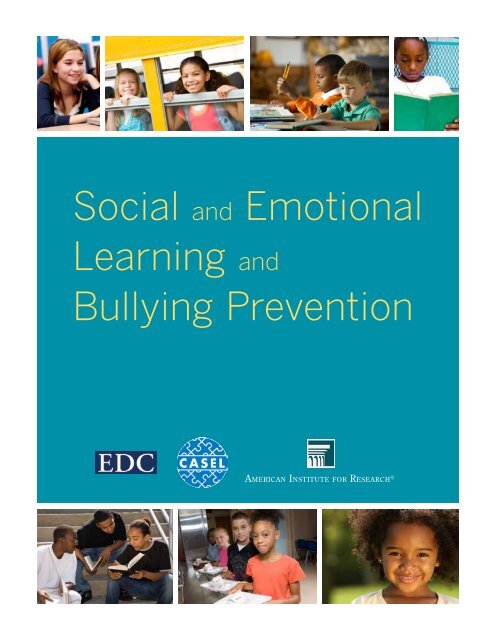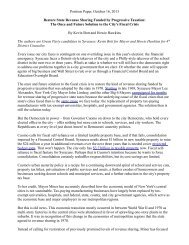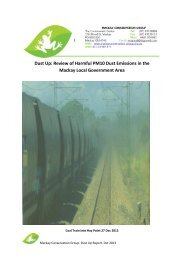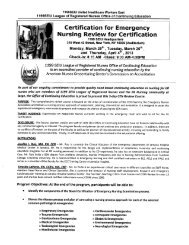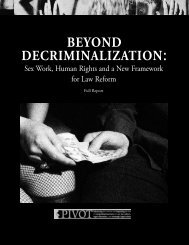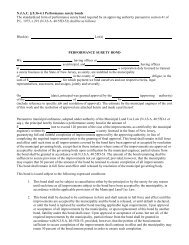SEL-and-Bullying-Prevention
SEL-and-Bullying-Prevention
SEL-and-Bullying-Prevention
You also want an ePaper? Increase the reach of your titles
YUMPU automatically turns print PDFs into web optimized ePapers that Google loves.
Overview: While bullying is a pervasive problem in many schools, schools can take specificsteps to improve the school climate <strong>and</strong> encourage positive interactions designed to reduce orprevent bullying. Schools using a social <strong>and</strong> emotional learning (<strong>SEL</strong>) framework can fosteran overall climate of inclusion, warmth, <strong>and</strong> respect, <strong>and</strong> promote the development of coresocial <strong>and</strong> emotional skills among both students <strong>and</strong> staff. Because bullying prevention isentirely congruent with <strong>SEL</strong>, it can be embedded in a school’s <strong>SEL</strong> framework. The aims ofthis brief are to (a) provide a basic description of a school-wide <strong>SEL</strong> framework, (b) illustratethe relationship between social <strong>and</strong> emotional factors <strong>and</strong> bullying, <strong>and</strong> (c) explain how an<strong>SEL</strong> framework can be extended to include bullying prevention.Research, Practices, Guidelines, <strong>and</strong> Resources<strong>Bullying</strong> may be the most frequent form of school violence (Nansel et al., 2001). Surveysconsistently indicate that almost one-quarter of all students experience hurtful interactionswith peers on a monthly or daily basis (Dinkes, Cataldi, & Lin-Kelly, 2007).State legislatures are increasingly requiring schools to develop <strong>and</strong> implement bullyingprevention policies <strong>and</strong> approaches (National Council of State Legislatures, n.d.). 1But even without these legislative m<strong>and</strong>ates, many schools are addressing bullying aspart of their efforts to create physically <strong>and</strong> emotionally safe learning environments.Because much remains to be learned about best practices in bullying prevention,when schools seek to identify a bullying prevention program to implement, they facea confusing array of interventions, many of which have not been evaluated or haveproduced only marginal gains in reducing bullying behaviors (Merrell, Gueldner, Ross,& Isava, 2008).Research does indicate, however, that multifaceted approaches to reducing bullying inschools are more likely to succeed than single-component programs. Such programsmay include a school-wide component centered on training, awareness, monitoring,<strong>and</strong> assessment of bullying; a classroom component focused on reinforcing schoolwiderules <strong>and</strong> building social <strong>and</strong> emotional skills, such as social problem solving<strong>and</strong> empathy; <strong>and</strong> an intervention component for students who are frequent targets orperpetrators of bullying. Programs directed at only one of these levels, or interventionsdesigned only for the targets <strong>and</strong> perpetrators of bullying, are less likely to beeffective (Birdthistle et al., 1999; Ttofi & Farrington, 2009; Vreeman & Carroll, 2007).When schools are able to scaffold bullying prevention onto a larger, more comprehensiveframework for prevention <strong>and</strong> positive youth development, they strengthen theirprevention efforts while also addressing some of the underlying contributing social,emotional, <strong>and</strong> environmental factors that can lead to bullying. A social <strong>and</strong> emotionallearning (<strong>SEL</strong>) framework can serve just this purpose.1See http://www.bullypolice.org for a list of state-by-state laws <strong>and</strong> related information.Social <strong>and</strong> Emotional Learning <strong>and</strong> <strong>Bullying</strong> <strong>Prevention</strong>2
What Is <strong>SEL</strong>?<strong>SEL</strong> is an educational movement gaining ground throughout the world. It focuses onthe systematic development of a core set of social <strong>and</strong> emotional skills that help childrenmore effectively h<strong>and</strong>le life challenges <strong>and</strong> thrive in both their learning <strong>and</strong> theirsocial environments. The Collaborative for Academic, Social, <strong>and</strong> Emotional Learning(CA<strong>SEL</strong>) defines <strong>SEL</strong> as the processes through which children <strong>and</strong> adults acquire theknowledge, attitudes, <strong>and</strong> skills they need to recognize <strong>and</strong> manage their emotions,demonstrate caring <strong>and</strong> concern for others, establish positive relationships, makeresponsible decisions, <strong>and</strong> h<strong>and</strong>le challenging social situations constructively.CA<strong>SEL</strong> has identified five core categories of social <strong>and</strong> emotional skills:• Self-awareness—accurately assessing one’s feelings, interests, values, <strong>and</strong> strengths/abilities, <strong>and</strong> maintaining a well-grounded sense of self-confidence• Self-management—regulating one’s emotions to h<strong>and</strong>le stress, control impulses,<strong>and</strong> persevere in overcoming obstacles; setting personal <strong>and</strong> academic goals <strong>and</strong>then monitoring one’s progress toward achieving them; <strong>and</strong> expressing emotionsconstructively• Social awareness—taking the perspective of <strong>and</strong> empathizing with others;recognizing <strong>and</strong> appreciating individual <strong>and</strong> group similarities <strong>and</strong> differences;identifying <strong>and</strong> following societal st<strong>and</strong>ards of conduct; <strong>and</strong> recognizing <strong>and</strong> usingfamily, school, <strong>and</strong> community resources• Relationship skills—establishing <strong>and</strong> maintaining healthy <strong>and</strong> rewarding relationshipsbased on cooperation; resisting inappropriate social pressure; preventing, managing,<strong>and</strong> resolving interpersonal conflict; <strong>and</strong> seeking help when needed• Responsible decision-making—making decisions based on consideration of ethicalst<strong>and</strong>ards, safety concerns, appropriate st<strong>and</strong>ards of conduct, respect for others,<strong>and</strong> likely consequences of various actions; applying decision-making skills toacademic <strong>and</strong> social situations; <strong>and</strong> contributing to the well-being of one’s school<strong>and</strong> communityThese skills allow children to calm themselves when angry, initiate friendships, resolverelationship conflicts respectfully, <strong>and</strong> make ethical <strong>and</strong> safe choices. To develop thesecapacities, children need to experience safe, nurturing, <strong>and</strong> well-managed environmentswhere they feel valued <strong>and</strong> respected; to have meaningful interactions withothers who are socially <strong>and</strong> emotionally competent; <strong>and</strong> to receive positive <strong>and</strong> specificguidance.Many excellent <strong>SEL</strong> curricula <strong>and</strong> programs are available that provide sequential <strong>and</strong>developmentally appropriate instruction in <strong>SEL</strong> skills, <strong>and</strong> structured opportunitiesfor children to practice, apply, <strong>and</strong> be recognized for using these skills throughoutthe day. <strong>SEL</strong> programs are ideally implemented in a coordinated manner throughoutthe school district, from preschool through high school. Lessons are reinforcedin both classroom <strong>and</strong> non-classroom settings (such as the hallways, cafeteria, <strong>and</strong>Social <strong>and</strong> Emotional Learning <strong>and</strong> <strong>Bullying</strong> <strong>Prevention</strong>3
playground), as well as during out-of-school activities <strong>and</strong> at home. Educators receiveongoing professional development in <strong>SEL</strong>, <strong>and</strong> families <strong>and</strong> schools work together topromote children’s social, emotional, <strong>and</strong> academic success.What Is <strong>Bullying</strong>?In its Safe Communities ~ Safe Schools Fact Sheet, the Center for the Study <strong>and</strong><strong>Prevention</strong> of School Violence (2008) uses three criteria to distinguish bullying fromother occurrences of misbehavior or isolated cases of aggression:1. It is aggressive behavior or intentional harm-doing.2. It is carried out repeatedly <strong>and</strong> over time.3. It occurs within an interpersonal relationship characterized by an imbalance of power.Thus, a student is bullied or victimized when he or she is the repeated target of deliberatenegative actions by one or more students who possess greater verbal, physical,social, or psychological power.Direct bullying is a relatively open attack on a victim that is physical (hitting, kicking,pushing, choking) <strong>and</strong>/or verbal (name calling, threatening, taunting, malicious teasing)in nature. Indirect bullying is more subtle <strong>and</strong> difficult to detect. It involves one ormore forms of relational aggression, including social isolation, intentional exclusion,rumor-spreading, damaging someone’s reputation, making faces or obscene gesturesbehind someone’s back, <strong>and</strong> manipulating friendships <strong>and</strong> other relationships.Students increasingly bully others using electronic communication devices <strong>and</strong> theInternet. Cyberbullying involves sending hurtful or threatening text messages <strong>and</strong>images with these devices in order to damage the target’s reputation <strong>and</strong> relationships.This form of bullying can be very difficult for adults to detect or track, <strong>and</strong> almosthalf of those victimized do not know the identity of the perpetrator. Electronic bullyingmost commonly involves the use of instant messaging, chat rooms, <strong>and</strong> e-mail(Kowalski & Limber, 2007).<strong>Bullying</strong> Prevalence <strong>and</strong> ConsequencesAccording to the 2008 Indicators of School Crime <strong>and</strong> Safety report from the Instituteof Education Sciences, 24 percent of elementary <strong>and</strong> secondary schools report daily orweekly bullying incidents (Dinkes et al., 2009). The frequency of actual bullying incidentsis probably much greater, since adults are often unaware of, or fail to adequatelyrespond to, bullying (Pepler & Craig, 2000). In 2007, 32% of students ages 12–18reported being bullied within the past year, with 63% percent of these students bulliedonce or twice over the year, 21 percent bullied once or twice a month, 10 percent bulliedonce or twice a week, <strong>and</strong> 7 percent bullied almost every day.Social <strong>and</strong> Emotional Learning <strong>and</strong> <strong>Bullying</strong> <strong>Prevention</strong>4
Most forms of bullying begin to decline by the end of the elementary grades <strong>and</strong>continue to decrease through the middle <strong>and</strong> high school grades. This decline istemporarily reversed, however, if students transition from an elementary school to amiddle school or junior high school during the middle grades. In these cases, there isfrequently a spike in bullying during that transition year, perhaps reflecting a desirefor students to reestablish dominance or achieve a position of leadership (Pelligrini,2002).The damage to victimized children is compounded by the relatively stable nature ofvictimization, such that the same children often remain victims from one school yearto the next (Nansel, Haynie, & Simons-Morton, 2007). Consequences for such childreninclude emotional distress, such as loneliness, anxiety, <strong>and</strong> depression, as well aspoor school performance <strong>and</strong> attendance, low self-confidence <strong>and</strong> self-concept, <strong>and</strong>social marginalization. These effects can be very long-lasting. For example, being atarget of bullying during adolescence is linked to higher levels of depression <strong>and</strong> anxietyin early adulthood (Dempsey & Storch, 2008).As for children who bully, while some socially “high status” bullies often appear welladjusted,other children who bully frequently experience a range of negative outcomes,including poorer school adjustment, more peer rejection, <strong>and</strong> more externalizing <strong>and</strong>internalizing behaviors, such as conduct problems, delinquency, criminal activity, <strong>and</strong>depression (Paul & Cillessen, 2007; Vreeman & Carroll, 2007; Whitted & Dupper, 2005).Witnessing bullying incidents can produce feelings of anger, fear, guilt, <strong>and</strong> sadness inobservers (Batsche & Porter, 2006). Byst<strong>and</strong>ers who witness repeated victimizationof peers can experience negative effects similar to the victimized children themselves(Pepler & Craig, 2000).Social-Ecological Perspectives on <strong>Bullying</strong>Although the definition of bullying focuses on the aggressive behavior of individualstudents, bullying is actually a group phenomenon, playing out in a social context(Salmivalli, 1999). It is important to remember that many students engage in someform of bullying behavior on a periodic basis, <strong>and</strong> that most students are teased orexperience some form of peer harassment during the school year (Espelage & Swearer,2003). Peers are also present as byst<strong>and</strong>ers during most bullying episodes <strong>and</strong> playa pivotal role in either the prevention or the promotion of bullying (Storey & Slaby,2008). For these reasons, some researchers stress that bullying should be viewed alonga continuum, rather than a categorical labeling of some children as bullies, othersas victims, <strong>and</strong> the remainder of students (<strong>and</strong> adults) as uninvolved (Espelage &Swearer, 2003). Others caution that labeling children further contributes to a negativeclimate, overemphasizes the role of individual children while minimizing contextualfactors, <strong>and</strong> fails to accentuate the positive capacities of children to contribute <strong>and</strong>interact in positive ways (Brown, 2008).There are numerous individual, peer-level, school-level, familial, <strong>and</strong> community factorsthat influence bullying. At the level of the peer group, social theories describingwhy bullying increases during late childhood <strong>and</strong> early adolescence include homoph-Social <strong>and</strong> Emotional Learning <strong>and</strong> <strong>Bullying</strong> <strong>Prevention</strong>5
ily theory, dominance theory, <strong>and</strong> attraction theory, <strong>and</strong> there is some researchevidence supporting each (Espelage & Swearer, 2003). Homophily theory states thatpeople tend to form friendships <strong>and</strong> spend time with those who are similar to themin certain key ways. Students tend to hang out with others who bully at the samefrequency, <strong>and</strong> among these bully-prone groups, bullying frequency increases overtime. According to dominance theory, students use bullying as a strategy for movinghigher in the social pecking order, particularly during the transition from elementaryschool to the middle grades, when patterns of social hierarchy are being established.Attraction theory posits that as children enter middle school, their attractionto aggressive peers increases.Family interaction patterns may also influence peer interaction patterns. Childrenwho are both victims <strong>and</strong> perpetrators of bullying at school are much more likely toalso bully <strong>and</strong>/or be victimized by siblings (Duncan, 1999). Parents of children whobully others are more likely to lack emotional warmth <strong>and</strong> be overly permissive (Rigby,1994). Parents of victimized children, in contrast, are more likely to be highly restrictive,controlling, <strong>and</strong> over-involved (Bowers, Smith, & Binney, 1994).The Connection Between <strong>SEL</strong><strong>and</strong> <strong>Bullying</strong> <strong>Prevention</strong>Given these contributing social factors, preventing <strong>and</strong> reducing bullying requires afocus on the social, emotional, <strong>and</strong> moral climate of the school, as well as on the social<strong>and</strong> emotional competence of the entire school body (Bosaki, Marini, & Dane, 2006;Knoff, 2007; San Antonio & Salzfass, 2007; Vreeman & Carroll, 2007; Whitted &Dupper, 2005). Although much remains to be learned about best practices for bullyingprevention <strong>and</strong> intervention, the existing research suggests that universal schoolbasedprevention programs (i.e., those designed for all children) can be effective. Arecent report by the Task Force on Community Preventive Services (Hahn et al., 2007)concluded that universal school-based programs designed to prevent or reduce violentbehavior, including bullying, significantly reduced rates of violent behavior <strong>and</strong>aggression for all grade levels.Vreeman <strong>and</strong> Carroll (2007), in their systematic review of school-based interventionsdesigned to prevent bullying, concluded that the most effective interventions typicallyuse a whole-school approach consisting of some combination of school-wide rules <strong>and</strong>sanctions, teacher training, classroom curricula, conflict resolution training, <strong>and</strong> individualcounseling. Anti-bullying programs exclusively directed at the bully, the victim,or both, without involving other students or addressing larger school climate issues,are less likely to be effective.In order to successfully address bullying problems, the entire school must comprise aculture of respect. Expectations for how staff <strong>and</strong> students treat one another shouldbe clearly reflected in school policies, <strong>and</strong> the rules for classroom interaction shouldbe consistently modeled by adults <strong>and</strong> enforced <strong>and</strong> reinforced in all school settings.Social <strong>and</strong> Emotional Learning <strong>and</strong> <strong>Bullying</strong> <strong>Prevention</strong>6
At the student level, schools using an <strong>SEL</strong> framework teach students skills in the areasof self-awareness, self-management, social awareness, relationships, <strong>and</strong> responsibledecision-making. These core <strong>SEL</strong> skills are the foundational competencies that studentsneed in order to deal with bullying. The six skills often overlap <strong>and</strong> complementone another, as illustrated below.Self-Awareness <strong>and</strong> Self-Management SkillsRecognize <strong>and</strong> manage emotions in order to respond to conflict in calm <strong>and</strong> assertiveways. In order to h<strong>and</strong>le conflicts effectively, children need to be able to recognizewhen they are getting angry, <strong>and</strong> learn to calm themselves before reacting. Childrenwho frequently bully others tend to have trouble managing anger <strong>and</strong> to strike outaggressively. Bosworth, Espelage, <strong>and</strong> Simon (1999) found that children who are theangriest are the most likely to bully others. Children report that the need to relievestress <strong>and</strong> having a bad day are the primary reasons they bully others (Swearer & Cary,2007).A recent study found that students expressing higher levels of sadness <strong>and</strong> emotionalinstability are more likely to be bullied (Analitis et al., 2009). Hyperactivity <strong>and</strong>emotional outbursts are the two factors most likely to annoy <strong>and</strong> provoke peers. Suchprovocation increases the likelihood of being victimized <strong>and</strong> not supported by peersover time (Rodkin & Hodges, 2003).Research suggests that many victims (43 percent) respond to being bullied in anaggressive, retaliatory, or emotionally reactive manner that both prolongs <strong>and</strong> escalatesthe bullying episode (Wilton, Craig, & Pepler, 2000). These victims lack effectiveemotional regulation skills <strong>and</strong> may yell, scream, or cry in response (the least effectiveways to stop bullying), thereby rewarding the aggressor (Goldbaum et al., 2006;Salmivalli, 1999) <strong>and</strong> making themselves more vulnerable to further victimization.Social AwarenessBe tolerant <strong>and</strong> appreciative of differences, <strong>and</strong> interact empathetically with peers.Research suggests that children often lack empathy for the victims of bullying, <strong>and</strong>that they view being different from the social ideal, or social norm, as the cause ofbullying (Swearer & Cary, 2007). When active byst<strong>and</strong>ers were asked why they choseto intervene, they were likely to attribute feelings of empathy for the victim <strong>and</strong> ageneral concern for the well-being of others as motivating factors. Byst<strong>and</strong>ers are alsomore likely to intervene when they have positive feelings <strong>and</strong> attitudes toward thevictim (Rigby & Johnson, 2006).Relationship SkillsInitiate <strong>and</strong> sustain friendships <strong>and</strong> other relationships. Victimized childrentend to have fewer friends, to only have friends who are also victimized, <strong>and</strong> to havemore enemies than non-victimized children (Rodkin & Hodges, 2003). Many aresocially withdrawn <strong>and</strong> lack confidence <strong>and</strong> skills in effectively interacting with peers(Pelligrini, 2002; Salmivalli, 1999). Because of their lack of peer support, victimizedSocial <strong>and</strong> Emotional Learning <strong>and</strong> <strong>Bullying</strong> <strong>Prevention</strong>7
children are less likely to have other children come to their defense when they are bullied(Rodkin & Hodges, 2003; Slaby, 2005).Research suggests that having high-quality friendships, or at least one best friend,can help prevent children from being victims (Boulton, Trueman, Chau, Whiteh<strong>and</strong>,& Amatya, 1999; Goldbaum, Craig, Pepler, & Connolly, 2006). Interventions thathelp peer-rejected children learn how to positively communicate with peers (e.g., askquestions, show support, make suggestions) can help them be more accepted by peers,less likely to be bullied, <strong>and</strong> more likely to be assisted by peers if targeted by a bully(Pelligrini, 2002).Resist social pressure to enable, encourage, or directly participate in bullying, <strong>and</strong>actively defend victims. Studies have revealed that when byst<strong>and</strong>ers observe bullying,they spend most of their time either actively participating in the act or passivelyencouraging the aggressor by serving as an audience; less than one-quarter of thetime do they try to assist the victim (O’Connell, Pepler, & Craig, 1999; Slaby, 2005).There are a variety of reasons that byst<strong>and</strong>ers don’t come to the assistance of victims:• They are intimidated by the social or physical power of those doing the bullying• They fear retaliation• They are reluctant to challenge group norms supporting bullying• They don’t recognize the act as bullying• They lack a sense of personal responsibility or self-confidence• They don’t know what to do to helpIt’s worth noting that when byst<strong>and</strong>ers do assert their disapproval of a bullying act,the episode usually ends quickly—in fewer than 10 seconds, in about half the cases(Craig & Pepler, 1997; Salmivalli, 1999).Be able to seek help from peers or other adults when needed. Research suggeststhat victims <strong>and</strong> byst<strong>and</strong>ers typically do not seek help from peers or adults when theyare unable to solve the problem on their own (O’Connell et al., 1999). Self-identifiedvictims are particularly likely to blame themselves for their victimization <strong>and</strong> to“suffer in silence” (Graham, Bellmore, & Juvonen, 2006).Responsible Decision MakingThink through <strong>and</strong> resolve social problems effectively <strong>and</strong> ethically. Effective socialproblem-solving requires an accurate assessment of the situation. Research indicatesthat children who frequently bully tend to misinterpret social interactions as beingmore hostile, adversarial, or provocative than their peers do (Dodge, 1993). Thesechildren also tend to hold more supportive beliefs about using violence <strong>and</strong> are lessconfident about using nonviolent strategies to resolve conflict (Bosworth et al., 1999).Not surprisingly, these students’ relationships with friends <strong>and</strong> family members tendto be fraught with conflict (Society for Research in Child Development, 2008).Social <strong>and</strong> Emotional Learning <strong>and</strong> <strong>Bullying</strong> <strong>Prevention</strong>8
Problem-solving also requires an evaluation of possible <strong>and</strong> likely consequences.Youngsters who are both bullies <strong>and</strong> victims tend to be emotionally volatile <strong>and</strong> toreact aggressively before thinking through the consequences (Pelligrini, 2002).Bullies may narrowly consider the positive short-term consequences of bullying forthemselves, but are less likely to consider the negative consequences of their actionson others or on their own relationships over time (Arsenio & Lemerise, 2001).Because of the potentially anonymous nature of cyberbullying, students may be evenless likely to recognize <strong>and</strong> consider the effects that these actions will have on thevictims.Victims also often lack effective social problem-solving skills (Biggam & Power, 1999).Problem-solving strategies are 13 times more effective at de-escalating conflicts thanare the aggressive, retaliatory, or emotionally reactive responses most frequently usedby targeted children (Wilton et al., 2000). Even among victims who use a problemsolvingstrategy in response to bullying, the vast majority employ a passive strategy,such as avoiding, acquiescing to, or ignoring the bully, instead of a more effectiveassertive strategy, such as talking with others to find a solution or asking others forhelp (Wilton et al., 2000).Applying an <strong>SEL</strong> Framework to <strong>Bullying</strong>To effectively reduce bullying behavior, schools need to provide students with instruction<strong>and</strong> practice in applying their <strong>SEL</strong> skills to a variety of bullying situations. An<strong>SEL</strong> framework provides a supportive foundation for these prevention efforts. Ttofi<strong>and</strong> Farrington (2009) conducted a meta-analysis of 59 well-designed evaluations ofbullying interventions to identify the specific features that had the greatest impacton decreasing bullying behavior <strong>and</strong> rates of victimization. They found that the mostimportant components were parent training, improved playground supervision,disciplinary methods, school conferences or assemblies that raised awareness of theproblem, classroom rules against bullying, classroom management techniques fordetecting <strong>and</strong> dealing with bullying, <strong>and</strong> the work of peers to help combat bullying. 2Building on these findings <strong>and</strong> other <strong>SEL</strong> research, the following strategies can helpschools apply an <strong>SEL</strong> framework to bullying prevention.2While a bullying prevention curriculum is also generally believed to be an effective schoolwidestrategy, there were not sufficient studies to evaluate the effectiveness of specific classroomcurricula.Social <strong>and</strong> Emotional Learning <strong>and</strong> <strong>Bullying</strong> <strong>Prevention</strong>9
School-Wide ApproachesAssessmentSchools need to conduct an assessment in order to determine how often bullyingoccurs, the forms it takes (e.g., sexual harassment, relational aggression, cyberbullying),where the incidents occur, <strong>and</strong> how students <strong>and</strong> adults respond to such incidents.Experts recommend conducting bullying assessments annually in the spring,after peer groups have formed in schools (Swearer, Espelage, Love, & Kingsbury,2008). See “Selected Resources” at the end of this brief for sample assessments.Awareness <strong>and</strong> TrainingAll adults who oversee groups of children (staff <strong>and</strong> volunteers) need to be trained torespond to bullying incidents. School staff, students, <strong>and</strong> parents need to be awareof what bullying is, the various forms that it can take, the factors that put children atrisk for victimization, the warning signs that a child has been victimized, <strong>and</strong> whatthey should do when bullying occurs. Adults <strong>and</strong> students need to examine their ownbeliefs about bullying <strong>and</strong> its causes <strong>and</strong> consequences.Numerous helpful resources exist for developing this awareness. Eyes on <strong>Bullying</strong>: WhatCan You Do? (Storey & Slaby, 2008), for example, is a downloadable toolkit designed tohelp children <strong>and</strong> adults examine their beliefs about bullying, learn how to recognize<strong>and</strong> effectively respond to bullying both at the time of the incident <strong>and</strong> after it hasended, <strong>and</strong> take strategic steps to help prevent bullying from occurring. Additionalresources can be found under “Selected Resources.”Rules <strong>and</strong> Reporting ProceduresWhen staff reach a consensus on what bullying is <strong>and</strong> agree to intervene to prevent<strong>and</strong> reduce it, rates of bullying can drop significantly (Wright, 2004). To help establishthe moral climate of the school, school-wide rules prohibiting bullying need to bedeveloped, with students as part of the process. The rules then need to be clearly communicated<strong>and</strong> distributed in writing (Whitted & Dupper, 2005). Examples of rules aschool might establish are as follows:• We will not bully others.• We will try to help students who are bullied.• We will include students who are easily left out.• When we know somebody is being bullied, we will tell an adult at school <strong>and</strong> at home(West Regional Equity Network, 2008).There is some evidence that children who frequently bully others are more morallydisengaged <strong>and</strong> view bullying behavior as much more acceptable or justified (Hymel,Rocke-Henderson, & Bonanno, 2005). Clear st<strong>and</strong>ards of conduct that do not allowSocial <strong>and</strong> Emotional Learning <strong>and</strong> <strong>Bullying</strong> <strong>Prevention</strong>10
ullying can help to decrease this disengagement among both students who bullyothers <strong>and</strong> byst<strong>and</strong>ers who witness the acts.Anonymous reporting procedures should also be established <strong>and</strong> communicated.Discipline PolicyThe discipline policy should clearly indicate that bullying is not acceptable, specify theconsequences for policy violations, <strong>and</strong> be consistently enforced.However, according to Swearer et al. (2008), the traditional punitive <strong>and</strong> reactiveresponses to bullying, such as zero-tolerance policies <strong>and</strong> security equipment<strong>and</strong> personnel, often cause problem behaviors to increase rather than diminish.Such responses are also not effective ways to improve school climate or academicengagement.The consequences for policy violations around bullying should instead include someform of remediation that helps students underst<strong>and</strong> the incident <strong>and</strong> practice prosocialbehaviors.Adult SupervisionAs determined by the assessment, all areas where bullying tends to occur (e.g., hallways,cafeteria, playground) should be adequately monitored by adults.Adult Models of BehaviorAdults in the school need to model respectful <strong>and</strong> caring behavior toward students<strong>and</strong> one another, <strong>and</strong> demonstrate social problem-solving skills. For example, a principalwho has lunch with a small group of students once a week demonstrates caringfor the students on the part of the administration (<strong>and</strong> also promoted cohesivenessamong the students by helping them learn more about one another).Adults also need to model active byst<strong>and</strong>er behavior by intervening quickly when bullyingincidents occur <strong>and</strong> by not dismissing or minimizing bullying (Slaby, 2005).Promoting Positive Peer InteractionsCreating opportunities for students to interact with one another in cooperative, positive,<strong>and</strong> inclusive ways can help generate cohesion <strong>and</strong> compassion among students<strong>and</strong> encourage them to apply the <strong>SEL</strong> skills they have been taught. At times whenadult supervision is less available, such as during recess, problem behaviors amongstudents can be reduced by giving them access to a variety of games <strong>and</strong> sportingequipment, such as Frisbees, hula-hoops, <strong>and</strong> Bingo (Swearer et al., 2008).Social <strong>and</strong> Emotional Learning <strong>and</strong> <strong>Bullying</strong> <strong>Prevention</strong>11
During the transition from elementary to middle school, promoting ongoing <strong>and</strong>cooperative interactions among groups of students is especially important. Someschools have students remain in intact cohorts throughout the year to encourage <strong>and</strong>increase cohesion among the group (Pelligrini, 2002).Classroom ApproachesClassroom ClimateTeachers play an enormously important role in setting the classroom climate. Ifaggressive norms become established <strong>and</strong> are not corrected, the students in theseclassrooms display more aggressive acts in future years (Rodkin & Hodges, 2003). AsRodkin <strong>and</strong> Hodges (2003) state:Teachers lie just outside of the peer ecology <strong>and</strong> help shape, intentionally or unintentionally,the critical microsystems in which children at school interact. Successful teachers guide childrentoward higher levels of moral reasoning, show warmth, <strong>and</strong> anticipate interpersonalproblems by knowing their students’ social status, peer groups, friends <strong>and</strong> enemies (p. 391).Teachers need to establish respectful st<strong>and</strong>ards of conduct for interactions <strong>and</strong> takeaction when student norms support aggression. Teachers need to work with studentsto develop classroom rules for respectful interactions, <strong>and</strong> to hold periodic classroommeetings to discuss bullying.Classroom activities <strong>and</strong> discussions that help change students’ views about the“coolness” of bullying may represent an important strategy for reducing bullying(Rodkin & Hodges, 2003). Because of their social power among peers, “high status”bullies can have a particularly negative impact on the overall classroom climate(Rodkin & Hodges, 2003)—<strong>and</strong> when the peer group norms favor bullying, aggressiveacts among both boys <strong>and</strong> girls increase, particularly at the middle school level.However, if other students <strong>and</strong> adults disapprove of bullying, <strong>and</strong> this disapprovalis reflected not only in the school rules but also in the established classroom climate,students may suffer a “social cost” when they bully, <strong>and</strong> may be less likely to do so(Arsenio & Lemerise, 2001).Teachers should model inclusive behaviors, making a special effort to reach out topeer-rejected <strong>and</strong> withdrawn students <strong>and</strong> to encourage students to be inclusive oftheir peers. There is evidence that when teachers are warm <strong>and</strong> caring to everyone,including aggressive <strong>and</strong> peer-rejected children, all students in the classroom are lessrejecting of their peers (Rodkin & Hodges, 2003). Peer-rejected children should havea valued <strong>and</strong> respected place in the classroom, for example, as an “expert” in somecontent or skill area or as a classroom assistant.Teachers should work to promote caring learning communities through such strategiesas class meetings, group celebrations, <strong>and</strong> cooperative group work (San Antonio &Salzfass, 2007).Social <strong>and</strong> Emotional Learning <strong>and</strong> <strong>Bullying</strong> <strong>Prevention</strong>12
<strong>SEL</strong> Curricula <strong>and</strong> ActivitiesHelping children think about the harmful consequences of their bullying behaviorson others <strong>and</strong> on their own relationships may reduce these behaviors. Students needopportunities to practice their <strong>SEL</strong> skills by role-playing how to respond appropriatelyin bullying situations. For example, when learning about empathy, studentscan discuss what it feels like to be bullied <strong>and</strong> to watch an incident of bullying. Theycan practice effective responses to bullying situations <strong>and</strong> help-seeking behaviors forboth victims <strong>and</strong> byst<strong>and</strong>ers. Teachers can brainstorm with students how byst<strong>and</strong>ersshould behave, <strong>and</strong> then practice these actions in role-play situations. Teachers shouldthen encourage students to apply what they are learning outside the classroom.Giving children opportunities to practice effective helping behaviors can help themdevelop the confidence to intervene in bullying situations, as they are more likely todo so once they have done it successfully, even in a role play (Rigby & Johnson, 2004).Children who actively defend victims of bullying tend to feel more confident than theirpeers about how to help victims <strong>and</strong> how to do it effectively (Gini, Albiero, Benelli, &Altoè, 2008).Likewise, prevention curricula are much more likely to significantly reduce rates of bullying<strong>and</strong> victimization when students have opportunities to apply what they learn in theclassroom to real-life situations (Hirschstein, Edstrom, Frey, Snell, & MacKenzie, 2007).See “Selected Resources” for suggested classroom curricula <strong>and</strong> activities.InterventionsBeyond classroom curricula, students who are victimized, who witness bullying, orwho regularly bully others need extended opportunities to practice relevant <strong>SEL</strong> skills,such as anger management, assertive communication, <strong>and</strong> social problem-solving.Pairing at-risk children with more well-adjusted <strong>and</strong> socially competent peers througha buddy system may help less socially <strong>and</strong> emotionally competent children developthese skills, <strong>and</strong> may also help protect at-risk children from further victimization(Rodkin & Hodges, 2003).Schools also need to establish a support system for victims of bullying, as some mayneed therapeutic interventions to address their resulting psychological issues, such asdepression <strong>and</strong> anxiety. Victimized children who are in pernicious bully-victim dyadswith another child may benefit from the intervention of a school psychologist orsocial worker (Rodkin & Hodges, 2003).Parental InvolvementSince family interaction patterns can contribute to both bullying behavior <strong>and</strong> victimization,it’s important to help parents reflect on their own parenting styles <strong>and</strong>behavior, <strong>and</strong> to provide them with specific guidance on h<strong>and</strong>ling conflicts at home.Parents also need guidance on how to best encourage the adoption of prosocial values<strong>and</strong> promote social <strong>and</strong> emotional skill development.Social <strong>and</strong> Emotional Learning <strong>and</strong> <strong>Bullying</strong> <strong>Prevention</strong>13
Selected ResourcesAmerican Association of University WomenThis organization’s free guide Harassment-Free Hallways: How to Stop SexualHarassment in Schools provides background information on the problem; surveysfor students to help them underst<strong>and</strong> what sexual harassment is, if they’ve beenvictimized, <strong>and</strong> what they should do if they are harassed; <strong>and</strong> recommended actionsfor schools <strong>and</strong> parents to help prevent sexual harassment. http://www.aauw.org/research/upload/completeguide.pdf<strong>Bullying</strong> in Schools <strong>and</strong> What to Do About ItThis website by Dr. Ken Rigby provides background information on bullying, recommendedapproaches for schools to use, bullying assessment questionnaires, <strong>and</strong>articles about ways to help children become more active byst<strong>and</strong>ers. http://www.education.unisa.edu.au/bullying/CDC Violence CompendiumThis website offers a variety of downloadable assessment measures, many of whichrelate to bullying. http://www.cdc.gov/ncipc/pub-res/measure.htmCollaborative for Academic, Social, <strong>and</strong> Emotional Learning (CA<strong>SEL</strong>)CA<strong>SEL</strong>’s Safe <strong>and</strong> Sound guide (available at http://www.casel.org/pub/safe<strong>and</strong>sound.php) provides information on numerous outst<strong>and</strong>ing <strong>SEL</strong> programs that can beexp<strong>and</strong>ed on <strong>and</strong> directly applied to bullying. Below are some programs that havespecifically extended their <strong>SEL</strong> instruction to include bullying:• Steps to Respect: Using this Committee for Children program, the schoolestablishes a school-wide framework of anti-bullying policies <strong>and</strong> procedures<strong>and</strong> determines consequences for bullying. Parents also receive materials aboutbullying. All school staff members are trained to work directly with childreninvolved in bullying incidents. Classroom teachers deliver the lessons in the upperelementary grades (3–5 or 4–6). Children learn <strong>and</strong> practice bullying preventionskills, including how to recognize, refuse, <strong>and</strong> report bullying, <strong>and</strong> how to makefriends. The website includes a sample lesson on byst<strong>and</strong>er involvement that maybe downloaded. http://www.cfchildren.org/media/files/str%5Fms%5Flesson.pdf• Lions Quest: This organization has prepared a bullying prevention documentthat summarizes how its programs address key elements of bullying prevention.It also offers an in-service workshop on bullying prevention for schools using itsprograms. http://www.lions-quest.org/Social <strong>and</strong> Emotional Learning <strong>and</strong> <strong>Bullying</strong> <strong>Prevention</strong>15
• Responsive Classroom (http://responsiveclassroom.org) <strong>and</strong> DevelopmentalStudies Center (http://www.devstu.org): These websites offer books, activityguides, <strong>and</strong> curricula that promote positive <strong>and</strong> inclusive student interactionsbetween students within the classroom <strong>and</strong> school-wide. The DevelopmentalStudies Center Caring School Community program has been found to significantlyreduce bullying in a large-scale evaluation.• Committee for Children: This organization has developed a bullying report forteachers using the Steps to Respect program, which can also serve as a helpfulchecklist for teachers to evaluate their classroom bullying prevention practices.http://www.cfchildren.org/media/files/str_sel_checklist.pdfThe accompanying Staff Preparedness Survey is designed for teachers to assess howprepared they feel to deal with bullying. http://www.cfchildren.org/media/files/STRStaffPrepSurvey.pdfEyes on <strong>Bullying</strong>This website offers information <strong>and</strong> activities on many bullying topics. Its downloadabletoolkit, Eyes on <strong>Bullying</strong>: What Can You Do?, includes activities to help children <strong>and</strong>adults recognize <strong>and</strong> respond to bullying. http://www.eyesonbullying.orgJim WrightSchool psychologist Jim Wright has prepared a free booklet for educators, titledPreventing Classroom <strong>Bullying</strong>: What Teachers Can Do, which lists concrete steps thatschools <strong>and</strong> classroom teachers can take to educate students about bullying. Includedare lesson ideas for having students practice assertive victim <strong>and</strong> byst<strong>and</strong>er responses,recommended classroom rules, tips on confronting students about bullying, considerationsfor providing appropriate consequences, activities to determine bullying “hotspots,” <strong>and</strong> recommended strategies for promoting inclusive behaviors among students.http://www.jimwrightonline.com/pdfdocs/bully/bullyBooklet.pdfMindOHThis website offers numerous resources on bullying, including <strong>Bullying</strong> Tips <strong>and</strong>Tools for teachers <strong>and</strong> parents, several “Thinking It Through” classroom lessons forstudents on bullying topics (e.g., teasing, byst<strong>and</strong>er roles), tips for preventingcyberbullying, an entire lesson plan series, <strong>and</strong> parent-child activities on bullying.http://www.mindoh.com/New Jersey Department of Education Model PolicyThis example of an anti-bullying policy lists factors to consider when determining consequences<strong>and</strong> appropriate remediation strategies, <strong>and</strong> suggests a range of individual,classroom, <strong>and</strong> school-wide responses to consider. http://www.state.nj.us/education/parents/bully.pdfSocial <strong>and</strong> Emotional Learning <strong>and</strong> <strong>Bullying</strong> <strong>Prevention</strong>16
Stop <strong>Bullying</strong> NowThis U.S. Department of Health <strong>and</strong> Human Services website is directed toward children,with 12 bullying “webisodes,” surveys to help kids underst<strong>and</strong> if they’re bullyingothers or are themselves a victim of bullying, <strong>and</strong> various other resources to helpchildren underst<strong>and</strong> what bullying is <strong>and</strong> the harm it does. http://stopbullyingnow.hrsa.gov/index.asp?area=mainSubstance Abuse <strong>and</strong> Mental Health Services AdministrationThis website offers a variety of helpful assessment tools, for example:• Inventory of Wrongful Activitieshttp://pathwayscourses.samhsa.gov/bully/pdfs_bully/bully_supps_pg3.pdf• H<strong>and</strong>ling of <strong>Bullying</strong> Staff Questionnairehttp://pathwayscourses.samhsa.gov/bully/pdfs_bully/bully_supps_pg4.pdfReferencesAnalitis, F., Velderman, M. K., Ravens-Sieberer, U., Detmar, S., Erhart, M., Herman,M., Berra, S., Alonso, J., Rajmil, L., & the European Kidscreen Group. (2009). Beingbullied: Associated factors in children <strong>and</strong> adolescents 8 to 18 years old in 11European countries. Pediatrics, 123(2), 569–577.Arsenio, W. F., & Lemerise, E. A. (2001). Varieties of childhood bullying: Values, emotionprocesses, <strong>and</strong> social competence. Social Development, 10(1), 59–73.Batsche, G. M., & Porter, L. J. (2006). <strong>Bullying</strong>. In G. G. Bear & K. M. Minke (Eds.),Children’s Needs III: Development, <strong>Prevention</strong>, <strong>and</strong> Intervention (pp. 135–148). Bethesda,MD: National Association of School Psychologists.Biggam, F. H., & Power, K. G. (1999). Social problem-solving skills <strong>and</strong> psychologicaldistress among incarcerated youth offenders: The issue of bullying <strong>and</strong> victimization.Cognitive Therapy <strong>and</strong> Research, 23(3), 307–326.Birdthistle, I., De Vos, E., Lang, C., Northrop, D., Slaby, R. G., & Whitman, C. V. (1999).Violence prevention: An important element of a health-promoting school. (World HealthOrganization Information Series on School Health #3.) Geneva, Switzerl<strong>and</strong>: WorldHealth Organization. Retrieved October 26, 2009, from www.who.int/school_youth_health/media/en/93.pdf.Bosaki, S. L., Marini, Z. A., & Dane, A. V. (2006). Voices from the classroom: Pictorial<strong>and</strong> narrative representations of children’s bullying experiences. Journal of MoralEducation, 35(2), 231–245.Social <strong>and</strong> Emotional Learning <strong>and</strong> <strong>Bullying</strong> <strong>Prevention</strong>17
Bosworth, K., Espelage, D. L., & Simon, T. R. (1999). Factors associated with bullyingbehavior in middle school students. Journal of Early Adolescence, 19(3), 341–362.Boulton, M. J., Trueman, M., Chau, C., Whiteh<strong>and</strong>, C., & Amatya, K. (1999).Concurrent <strong>and</strong> longitudinal links between friendship <strong>and</strong> peer victimization:Implications for befriending interventions. Journal of Adolescence, 22(4), 461–466.Bowers, L., Smith, P. K., & Binney, V. (1994). Perceived family relationships of bullies,victims, <strong>and</strong> bully/victims in middle childhood. Journal of Social <strong>and</strong> PersonalRelationships, 11(2), 215–232.Brown, L. M. (2008, March 4). Commentary: 10 ways to move beyond bullyingprevention (<strong>and</strong> why we should). Education Week. Retrieved March 4, 2008, fromhttp://www.educationweek.org.Center for the Study <strong>and</strong> <strong>Prevention</strong> of School Violence (2008). Safe schools, safe communities:Fact sheet. Retrieved October 26, 2009, from http://www.colorado.edu/cspv/publications/factsheets/safeschools/FS-SC07.pdf.Craig, W. M., & Pepler, D. (1997). Observations of bullying <strong>and</strong> victimization in theschool yard. Canadian Journal of School Psychology, 13(2), 41–60.Dempsey, A. G., & Storch, E. A. (February 2008). Relational victimization: The associationbetween recalled adolescent social experiences <strong>and</strong> emotional adjustment in earlyadulthood. Psychology In Schools, 45(4), 310–322.Dinkes, R., Kemp, J. & Baum, K. (2009). Indicators of School Crime <strong>and</strong> Safety: 2008(NCES 2009-022/NCJ 226343). Washington, DC: National Center for EducationStatistics, Institute of Education Sciences, U.S. Department of Education, <strong>and</strong> Bureauof Justice Statistics, Office of Justice Programs, U.S. Department of Justice. RetrievedNovember, 17, 2009, from http://nces.ed.gov or http://www.ojp.usdoj.gov/bjs.Dodge, K. A. (1993). Social-cognitive mechanisms in the development of conductdisorder <strong>and</strong> depression. Annual Reviews of Psychology, 44, 559–584.Duncan, R. D. (1999). Peer <strong>and</strong> sibling aggression: An investigation of intra- <strong>and</strong>extra-familial bullying. Journal of Interpersonal Violence, 14(8), 871–886.Espelage, D. L., & Swearer, S. M. (2003). Research on school bullying <strong>and</strong> victimization:What have we learned <strong>and</strong> where do we go from here? School Psychology Review,32(3), 365–383.Gini, G., Albiero, P., Benelli, B., & Altoè, G. (2008). Determinants of adolescents’ activedefending <strong>and</strong> passive byst<strong>and</strong>ing behavior in bullying. Journal of Adolescence, 31(1),93–105.Social <strong>and</strong> Emotional Learning <strong>and</strong> <strong>Bullying</strong> <strong>Prevention</strong>18
Goldbaum, S., Craig, W. M., Pepler, D., & Connolly, J. (2006). Developmental trajectoriesof victimization: Identifying risk <strong>and</strong> protective factors. In J. E. Zins, M. J. Elias,& C. A. Maher (Eds.), <strong>Bullying</strong>, victimization, <strong>and</strong> peer harassment (pp. 143–160). NewYork: Haworth Press.Graham, S., Bellmore, A., & Juvonen, J. (2006). Peer victimization in middle school:When self- <strong>and</strong> peer views diverge. In J. E. Zins, M. J. Elias, & C. A. Maher (Eds.),<strong>Bullying</strong>, victimization, <strong>and</strong> peer harassment (pp. 121–141). New York: Haworth Press.Hahn, R., Fuqua-Whitley, D., Wethington, H., Lowy, J., Liberman, A., Crosby, A., etal. (2007). The effectiveness of universal school-based programs for the prevention ofviolent <strong>and</strong> aggressive behavior: A report of recommendations of the Task Force onCommunity Preventive Services. Morbidity <strong>and</strong> Mortality Weekly Report, 56(RR07), 1–12.Hirschstein, M. K., Edstrom, L. V., Frey, K. S., Snell, J. L., & MacKenzie, E. P. (2007).Walking the talk in bullying prevention: Teacher implementation variables related toinitial impact of the Steps to Respect program. School Psychology Review, 36(1), 3–21.Hymel, S., Rocke-Henderson, N., & Bonanno, R. A. (2005). Moral disengagement:A framework for underst<strong>and</strong>ing bullying among adolescents. Journal of SocialSciences, 8(Special issue), 1–11.Knoff, H. M. (2007). Teasing, taunting, bullying, harassment, <strong>and</strong> aggression: A schoolwideapproach to prevention, strategic intervention, <strong>and</strong> crisis management. In J. E.Zins, M. J. Elias, & C. A. Maher (Eds.), <strong>Bullying</strong>, victimization, <strong>and</strong> peer harassment (pp.389–412). New York: Haworth Press.Kowalski, R. M., & Limber, S. P. (2007). Electronic bullying among middle schoolsstudents. Journal of Adolescent Health, 41(6, Supplement), S22–S30.Merrell, K. W., Gueldner, B. A., Ross, S. W., & Isava, D. M. (2008). How effective areschool bullying intervention programs? A meta-analysis of intervention research.School Psychology Quarterly, 23(1), 26–42.Nansel, T. R., Haynie, D. L., & Simons-Morton, B. G. (2007). The association of bullying<strong>and</strong> victimization with middle school adjustment. In J. E. Zins, M. J. Elias, & C.A. Maher (Eds.), <strong>Bullying</strong>, victimization, <strong>and</strong> peer harassment (pp. 49–65). New York:Haworth Press.Nansel, T. R., Overpeck, M., Pilla, R. S., Ruan, W. J., Simons-Morton, B., & Scheidt, P.(2001). <strong>Bullying</strong> behaviors among U.S. youth: Prevalence <strong>and</strong> associations with psychosocialadjustment. Journal of the American Medical Association, 285(16), 2094–2100.National Council of State Legislatures. (n.d.). Select school safety enactments (1994–2004): <strong>Bullying</strong> <strong>and</strong> student harassment. Retrieved September 5, 2007, from http://www.ncsl.org/programs/cyf/bullyingenac.htm.Social <strong>and</strong> Emotional Learning <strong>and</strong> <strong>Bullying</strong> <strong>Prevention</strong>19
O’Connell, P., Pepler, D. J., & Craig, W. M. (1999). Peer involvement in bullying:Insights <strong>and</strong> challengers for intervention. Journal of Adolescence, 22(4), 437–452.Paul, J. J., & Cillessen, A. H. N. (2007). Dynamics of peer victimization in early adolescence:Results from a four-year longitudinal study. In J. E. Zins, M. J. Elias, & C.A. Maher (Eds.), <strong>Bullying</strong>, victimization, <strong>and</strong> peer harassment (pp. 29–47). New York:Haworth Press.Pelligrini, A. D. (2002). <strong>Bullying</strong>, victimization <strong>and</strong> sexual harassment during the transitionto middle school. Educational Psychologist, 37(3), 151–163.Pepler, D. J., & Craig, W. M. (2000). Making a difference in bullying. LaMarsh ResearchReport # 60. Toronto: York University. Retrieved October 26, 2009, from http://psycserver.psyc.queensu.ca/craigw/Craig_Pepler_2000_REPORT_Making_a_Difference_n_<strong>Bullying</strong>.pdf.Rigby, K. (1994). Psychosocial functioning of families of Australian adolescent schoolchildreninvolved in bully/victim problems. Journal of Family Therapy, 16(2), 173–187.Rigby, K., & Johnson, B. (2004, September). Innocent byst<strong>and</strong>ers? Teacher, 38–40.Rigby, K., & Johnson, B. (2006). Expressed readiness of Australian schoolchildren toact as byst<strong>and</strong>ers in support of children who are being bullied. Educational Psychology,26(3), 425–440. Retrieved October 26, 2009, from http://www.education.unisa.edu.au/bullying/Byst<strong>and</strong>er-Educational-Psychology.pdf.Rodkin, P., & Hodges, E. V. E. (2003). Bullies <strong>and</strong> victims in the peer ecology: Fourquestions for psychologists <strong>and</strong> school professionals. School Psychology Review, 32(3),384–400.Salmivalli, C. (1999). Participant role approach to school bullying: Implications forinterventions. Journal of Adolescence, 22(4), 453–459. Retrieved October 26, 2009, fromhttp://www.education.unisa.edu.au/bullying/Byst<strong>and</strong>er-Educational-Psychology.pdf.San Antonio, D. M., & Salzfass, E. A. (2007). How we treat one another in school.Educational Leadership, 64(8), 32–38.Slaby, R. G. (2005). The role of byst<strong>and</strong>ers in preventing bullying. Health in Action,3(4), 6.Society for Research in Child Development. (2008, March 26). Children who bully alsohave problems with other relationships. ScienceDaily. Retrieved April 25, 2008, fromhttp://www.sciencedaily.com.Storey, K., & Slaby, R. (2008). Eyes on bullying: What can you do? Newton, MA:Education Development Center, Inc. Retrieved October 26, 2009, from http://www.eyesonbullying.org.Social <strong>and</strong> Emotional Learning <strong>and</strong> <strong>Bullying</strong> <strong>Prevention</strong>20
Swearer, S. M., & Cary, P. T. (2007). Perceptions <strong>and</strong> attitudes toward bullying inmiddle school youth: A developmental examination across the bullying continuum. InJ. E. Zins, M. J. Elias, & C. A. Maher (Eds.), <strong>Bullying</strong>, victimization, <strong>and</strong> peer harassment(pp. 67–83). New York: Haworth Press.Swearer, S. M., Espelage, D. L., Love, K. B., & Kingsbury, W. (2008). School-wideapproaches to intervention for school aggression <strong>and</strong> bullying. In B. Doll & J. A.Cummings (Eds.), Transforming school mental health services (pp. 187–212). Thous<strong>and</strong>Oaks, CA: Corwin Press.Ttofi, M. M., & Farrington, D. P. (2009). What works in preventing bullying:Effective elements of anti-bullying programs. Journal of Aggression, Conflict <strong>and</strong>Peace Research, 1(1), 13–24.Vreeman, R. C., & Carroll, A. E. (2007). A systematic review of school-based interventionsto prevent bullying. Archives of Pediatric Adolescent Medicine, 161(1), 78–88.West Regional Equity Network. (March 2008). <strong>Bullying</strong> <strong>and</strong> cyberprevention brochure.Tucson, AZ: University of Arizona. Retrieved October 26, 2009, from http://uacoe.arizona.edu/wren/publications.html.Whitted, K. S., & Dupper, D. R. (2005). Best practices for preventing or reducing bullyingin schools. Children <strong>and</strong> Schools, 27(3), 167–175.Wilton, M. M., Craig, W. M., & Pepler, D. J. (2000). Emotional regulation <strong>and</strong> displayin classroom victims of bullying: Characteristic expressions of affect, coping styles <strong>and</strong>relevant contextual factors. Social Development, 9(2), 226–245.Wright, J. (2004). Preventing classroom bullying: What teachers can do. RetrievedOctober 26, 2009, from http://www.interventioncentral.org.Social <strong>and</strong> Emotional Learning <strong>and</strong> <strong>Bullying</strong> <strong>Prevention</strong>21


